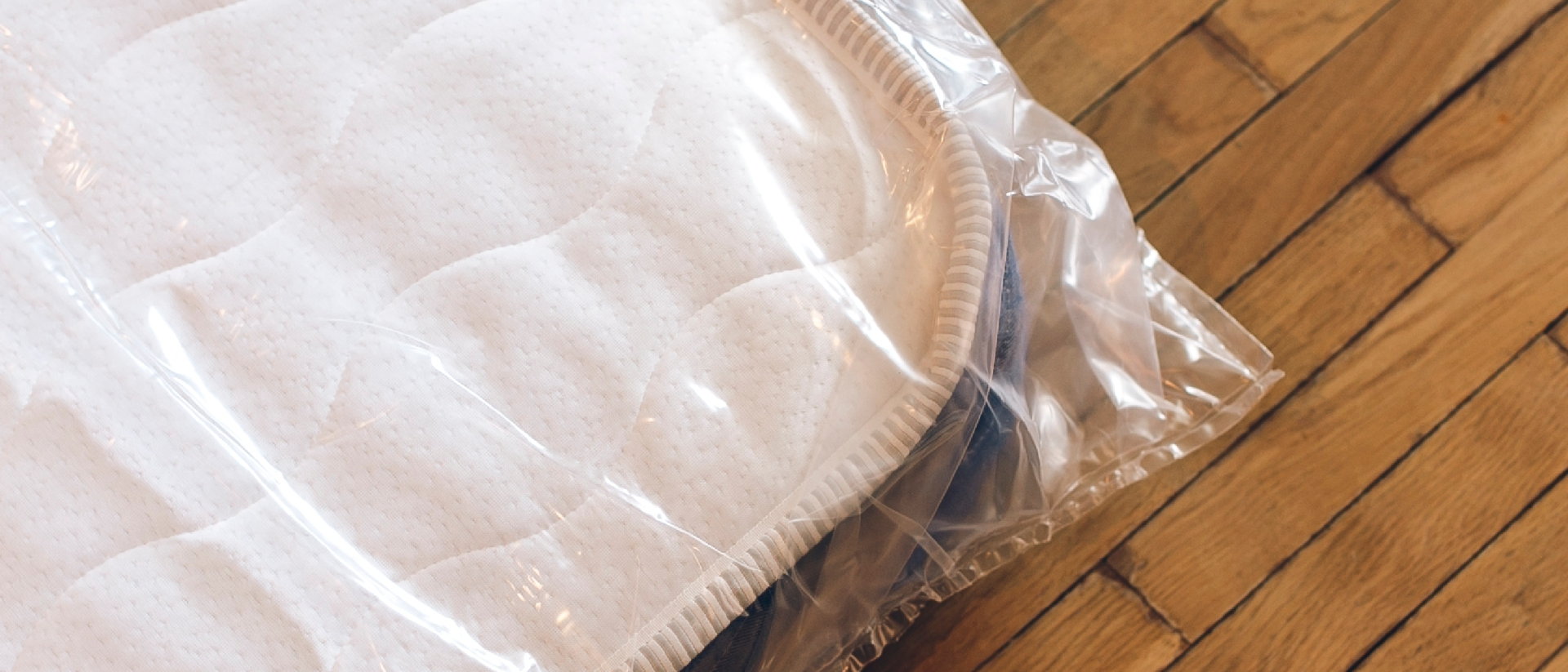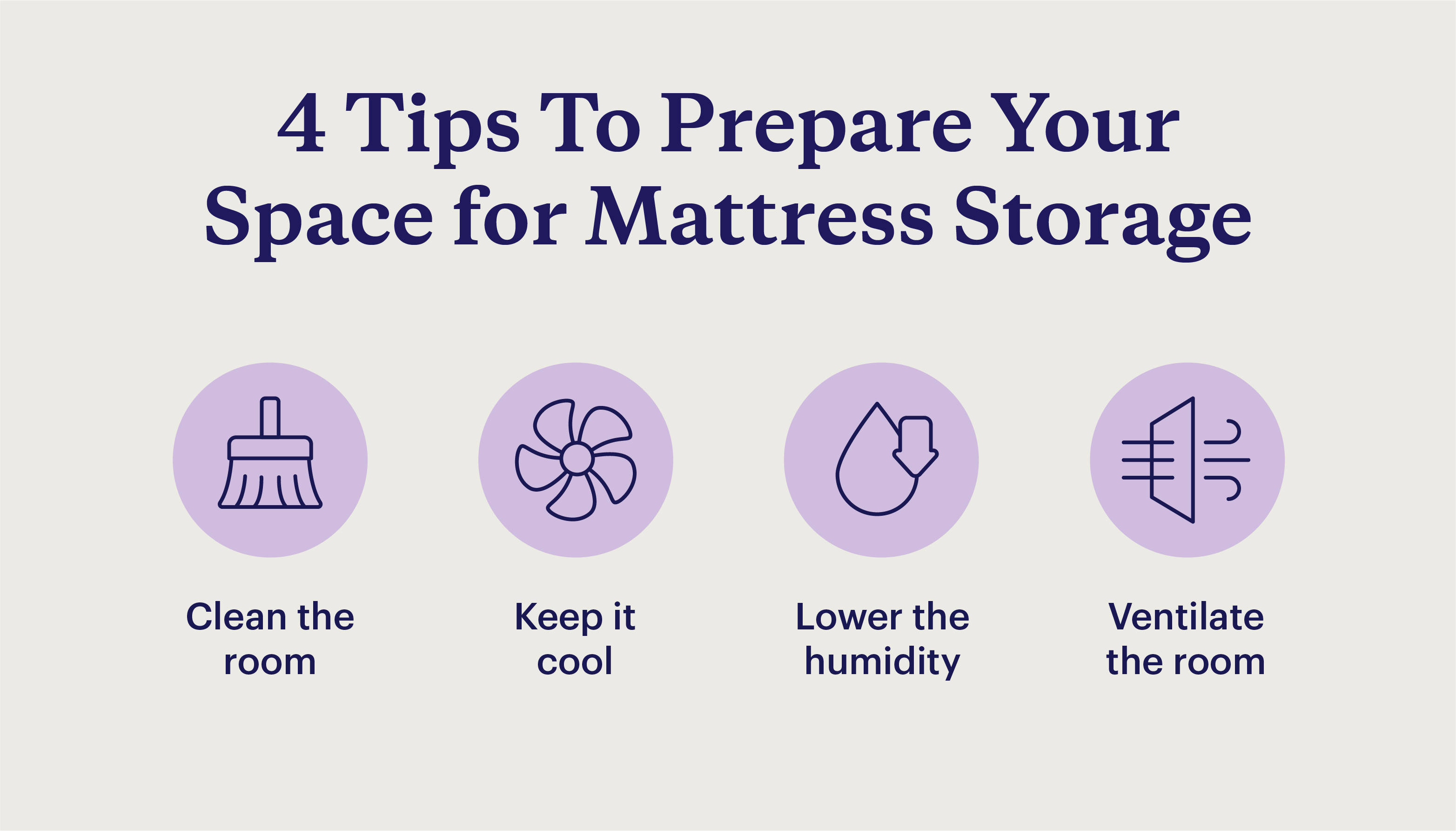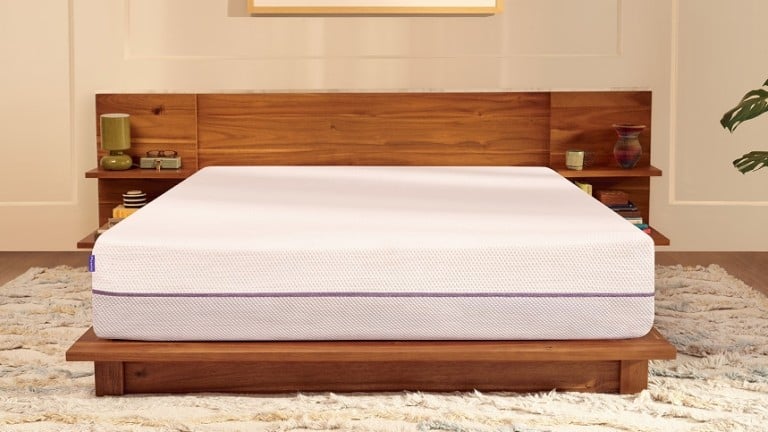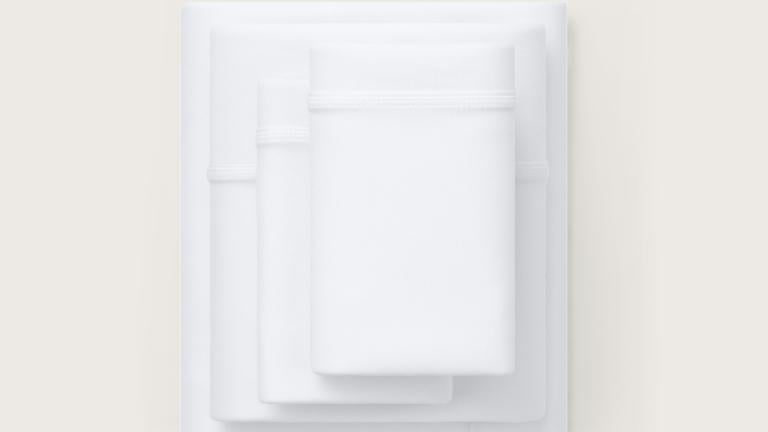
How To Store a Mattress: 7 Easy Steps + What Not To Do
Top Mattress Storage Tips
- Clean and air-dry your mattress thoroughly before putting it in storage.
- Cover your mattress with a mattress bag or thin plastic wrap to keep out pests, dirt, dust, and water.
- Check on your mattress while it’s in storage to make sure there are no signs of damage or warping.
Properly storing a mattress ensures it stays clean and maintains its structure until it’s needed once again. But what is the best way to store a mattress?
Cleanliness and protection from water, dust, dirt, and pests are essential to storage. Placement and position are also critical to maintaining the integrity of the inner components and layers.
In this guide, learn how to store a mattress and the key factors you should consider to keep different types of mattresses in great condition.
1. Clean Your Mattress
Be sure to clean your mattress before storing it. This helps prevent mold, mildew, and bacteria growth on the mattress. Here are a few key steps to take to ensure cleanliness before storing your mattress:
- Strip all bedding: Remove the comforter, sheets, pillowcases, and mattress protector before storing your mattress. If you want to continue using this bedding on another mattress, wash it according to care instructions before properly making your bed.
- Vacuum: Before you tackle any stubborn stains, use a hand vacuum attachment to remove dust, hair, and other debris from your mattress.
- Spot clean: Avoid using heavy-duty cleaners like bleach on your mattress. Instead, spot clean as needed with a mild detergent or mattress cleaner. Try to remove yellow stains from your mattress, and let it air dry before storing it.
- Use baking soda: Baking soda is a natural and cost-effective way to deodorize and remove stains from a mattress. Sprinkle baking soda on the entire surface of your mattress and let it sit for at least an hour. Then, vacuum all the baking soda from the exterior of your mattress.
- Air it out: Let your mattress air out for several hours to make sure it’s clean and dry before being put away. If your mattress isn’t completely dry, you’ll risk mold and mildew growth while it’s in storage.
For a more thorough clean, check out our guide on how to clean a mattress. If you’re dealing with particularly tough odors, here are five easy ways to deodorize a mattress.
2. Cover Your Mattress
Once your mattress is clean and dry, cover it to keep it dry, protect it from mold, and prevent it from accumulating additional dirt and debris.
You can use the same approach to keep your mattress clean and protected if you want to know how to wrap a mattress for moving.
Here are three best practices for how to cover a mattress for storage:
Mattress Storage Bag
One of the most recommended ways to protect a mattress is with a mattress storage bag. Designed specifically to protect your mattress, these bags are made with heavy-duty materials — usually plastic — to keep out dust, dirt, pests, and water.
To use a mattress cover bag, first recruit the help of one other person, then follow these steps:
- Place the mattress bag around the edge of the clean, dry mattress.
- Have the person helping you lift the other end as you pull the bag over the rest of the mattress.
- Make sure there is no moisture in the bag.
- Seal the bag, making sure there are no tears or gaps.
Plastic Wrap
If you don’t have a mattress bag, you can use thin plastic to cover your mattress for storage. Choose a breathable plastic to protect the mattress from dust and debris without trapping too much moisture.
Follow these steps to cover your mattress:
- Lay down a large sheet of plastic (just over double the size of the mattress) on a clean spot on the floor.
- Lay the mattress on top of the plastic sheet.
- Lift the plastic sheet up and over the mattress, covering the entire surface.
- Seal all the loose edges together with duct tape.
- Check for tears before moving the mattress into storage.
Moving Blankets
In a pinch, you can use moving blankets to wrap your mattress before moving. This method isn’t recommended because blankets won’t keep out pests and water. But if you’re only storing your mattress for a day or two, blankets will help keep out dust and debris.
If you’re using blankets, lay one down on a clean floor, then place your mattress on top. Cover your mattress with additional blankets and secure them with bungee cords or something similar.
No matter what you use to wrap your mattress, make sure you cover its entire surface before storing it.
3. Choose Your Mattress Storage Location
Since most mattresses are bulky, you’ll need ample space to store them. The most common storage locations for mattresses include:
Storage Unit
Climate-controlled storage units are the best choice for storing a mattress long term. These facilities keep your mattress from being exposed to moisture and high temperatures, which can shorten the lifespan of a mattress.
As for how to store a mattress in a storage unit, you’ll want to make sure the mattress is properly covered to protect it from dust and pests. Lay it flat to prevent warping.
Garage
Storing a mattress in a garage isn’t ideal because garages tend to accumulate dust and dirt. Additionally, equipment and other items stored in the space can fall on your mattress and cause damage.
If you don’t have a better option, knowing how to store a mattress in the garage can help protect your mattress. Wrapping the mattress thoroughly can prevent dirt, moisture, and debris from reaching it. Try to avoid storing your mattress on its side, as this position can cause deformities.
Spare Room
If you have the space, storing your mattress in a spare room is a great way to keep it protected from dust, moisture, and damage.
Ideally, you should lay your mattress flat on a clean area of the floor so it maintains its structure. However, if you want to know how to store a mattress against a wall, follow these tips:
- Wrap the mattress to protect it from dirt and dust.
- Secure the mattress to prevent warping.
- Rotate the mattress periodically.
- Inspect the mattress regularly.
Storing a mattress against a wall is not recommended because this position can cause the mattress to deform. You can temporarily store it upright, but avoid doing so for more than a few weeks if possible.
Basement
Basements are often dark and humid, making them unsuitable for mattress storage. If a basement is your only option, try to store your mattress in a clean, dry area and check on it frequently to detect any damage early.
4. Prepare the Space
Before you store your mattress, you need to make sure your storage location is clean, dry, and clear of obstructions.
You can protect mattresses in storage by controlling the following factors:
- Cleanliness: Vacuum or sweep the floor to remove dust, dirt, and debris. Remove anything that could stain your mattress.
- Temperature: A cool, climate-controlled space is ideal for storing mattresses. Keep the temperature as close to what you would normally prefer for your bedroom to protect your mattress.
- Humidity: Prevent mold and mildew by storing your mattress in a dry area. Use a dehumidifier or fan to keep the area dry.
- Ventilation: Sufficient ventilation can prevent your mattress from getting musty. Make sure any vents are open and circulating air, and use a fan for added airflow.
5. Secure and Transport Your Mattress
Moving a mattress can be tricky. Ideally, you should use a covered truck or trailer to move your mattress to your storage destination. However, if you cover your mattress and secure it well, you can use a truck with an open bed.
When placing a mattress inside a moving truck or on the back of a pickup truck, line the surface with blankets or sheets to protect the mattress exterior from damage. Use ratchet straps or rope to secure your mattress.
Laying your mattress flat without anything on top of it is the best way to transport it, but generally, it’s okay to prop a mattress on its side for short periods if necessary. If you’re transporting a mattress on its side, secure it to prevent it from sliding around.
6. Store Your Mattress Flat
When storing your mattress, you should lay it flat to prevent sagging and bulging. While it may seem more practical and space-efficient to store a mattress on its side, doing so for extended periods can affect its longevity. This is particularly true for hybrid and innerspring mattresses because the coils can become misshapen over time.
Lay the mattress flat on the ground, on a platform, or boxes with a level surface. If you plan on keeping your mattress in storage for more than a few months, you may need to flip it every so often, depending on the type of mattress you have. Flipping or rotating your mattress can help prevent sagging and extend the mattress’s life while it’s in storage or while you’re using it, especially if it’s an innerspring mattress.
It’s also important to avoid placing heavy objects on top of your mattress. Applying excess weight for long periods can cause sagging or deformations on the mattress.
7. Inspect Your Mattress After Storing
If you’ve properly covered and secured your mattress, storing it for a short time shouldn’t require any checkups. However, if you’re storing your mattress for more than a week or two, we recommend regularly inspecting your mattress for the following issues:
- Tears, rips, or other damage: If you notice that your mattress covering shows signs of damage, add extra layers or replace the covering to keep your mattress protected.
- Lumps or deformities: You should especially look for signs of warping if you’re storing your mattress on its side. If you see lumps or bulges, make sure there is nothing on top of or beneath the mattress that could be warping it. Lay it flat if possible to prevent further issues.
- Condensation or damp patches: If moisture gets inside your mattress covering, the trapped air and humidity can cause mold and mildew growth. Air out the mattress until it is completely dry before recovering.
Do’s and Don’ts of Storing a Mattress
It’s easy to cut corners when storing your mattress, but doing so can cause damage or deterioration. Consider the following do’s and don’ts of proper mattress storage:
Do’s
Best practices for storing a mattress include:
- Properly clean and dry your mattress before storing it. Taking steps to prepare your mattress will help keep it fresh and clean while in storage.
- Open the wrapping every few weeks to check if moisture, mold, or pests have made their way into the mattress.
- Keep your mattress out of rooms that are exposed to extreme temperatures. High heat can deform a mattress, while very low temperatures could freeze gel-infused memory foam. Repeated freezing and thawing cycles could eventually damage the mattress’s integrity.
- Line the surface with plastic sheets or blankets before laying down a mattress to keep moisture from seeping in.
Don’ts
When storing your mattress, here’s what you shouldn’t do:
- Don’t place heavy items like furniture on top of your mattress. This may cause premature sagging and potentially ruin your support coils.
- Don’t store your mattress on an uneven surface. This can cause lumps and other deformations.
- Don’t leave your mattress in a room with high humidity, as this can encourage mold and mildew growth.
- Don’t leave your mattress propped on its side. This can damage the foam or coils inside.
Do | Don’t |
| Vacuum and spot clean your mattress before storing it | Store your mattress in a humid room |
| Rest your mattress on a blanket or sheet of plastic | Place heavy items on your mattress |
| Store your mattress in a climate-controlled space | Stack mattresses on top of each other |
| Routinely check your mattress for moisture, mold, and pests | Place your mattress on an uneven surface |
| Air out your mattress regularly | Leave your mattress on its side for more than a few weeks |
How To Store Different Types of Mattresses
Each type of mattress has unique considerations when it comes to storage. There may be differences when storing a memory foam bed-in-a-box mattress vs. a traditional mattress, for example.
Here are a few considerations for how to store different types of mattresses:
- Latex mattresses: Latex mattresses are often heavier than other mattresses and shouldn’t be stored on their sides, as this position will put too much pressure on the upright half, eventually causing it to slump and deform.
- Spring mattresses: Designed with steel coils that provide support and stability, innerspring mattresses cannot be bent or rolled when transported. Spring coils tend to wear out faster than other mattress materials, so you shouldn’t put any heavy objects on top of it in storage.
- Hybrid mattresses: Hybrid mattresses have a combination of foam layers and interior springs to provide both comfort and support. Like with other mattress types, it’s best to keep heavy objects off the surface of a hybrid mattress to prevent sagging and lumps.
- Memory foam mattresses: Made of viscoelastic polyurethane foam, memory foam mattresses are quite heavy and can’t retain their shape when propped up on their sides, especially in high temperatures. Memory foam is very absorbent and difficult to dry, so you should use dry baking soda to clean it.
Storing a Purple Mattress
To store a Purple mattress, wrap it in plastic or a mattress bag, fold it in half, and tie it with a non-stretchy strap such as a nylon ratchet strap. Once you’re at your storage space, open the mattress up and lay it flat. Don’t place anything on top to avoid premature sagging.
How To Clean a Mattress That’s Been in Storage
Once you take your mattress out of storage, it’s important to check it thoroughly to ensure it’s still in good condition. Depending on how long you’ve been storing it and the conditions of your storage location, take the following steps to clean it before using it.
- Air it out: Over time, mattresses in storage may accumulate moisture and start to smell. Air it out in a well-ventilated space or in the sun for a few hours to get rid of any unwanted smells. If you’re dealing with a persistent musty smell, you can use baking soda to get rid of the odor.
- Check for dust mites: Before using your mattress, check for signs of dust mites, namely tiny brown or black spots. Vacuum your mattress to remove dust mites before sleeping on it.
- Vacuum: Even if you don’t see dust mite debris, it’s a good idea to vacuum your mattress when you take it out of storage to remove any dust or dirt that accumulates over time.
- Spot clean: If you notice any discoloration, spot clean with a mild cleaner. Make sure you let the mattress dry completely before putting any bedding on it. You can prevent further stains with a mattress protector once your mattress is clean, dry, and ready for use.
If you’re swapping out your current mattress for one in storage, there are several ways you can remove and dispose of your mattress. Depending on its condition and age, you can usually choose between selling, donating, and recycling it.
Make sure the mattress you had in storage is still in good condition before putting it on your bed. If the mattress shows signs of deterioration, damage, sagging, or warping, it may be time to consider buying a new mattress that will provide the support and comfort you need.
Mattress Storage FAQ
Typically, mattresses last about seven to 10 years. However, many variables can influence this. A few months or years of storage can damage a mattress depending on where and how you store it. If you’re storing a mattress for longer than a few months, be sure to inspect it regularly for signs of moisture, damage, and warping.
Generally, you shouldn’t stack mattresses. Mattresses can weigh upwards of 150 pounds, and having that much weight constantly resting on top of a mattress can shorten its lifespan prematurely.
If you absolutely must stack your mattresses, always lay them flat on top of one another, with the lightest on top and the heaviest at the base. Avoid storing mattresses like this longer than necessary to avoid long-term damage
It is not recommended to store a mattress on its side. Doing so can cause the inner support coils or foam layers to lose their shape, leading to poor support, sagging, lumps, and other issues, so it is best to lay it flat in storage.
While you should avoid storing mattresses on their sides, you can place a mattress on its side for a short period, generally up to a few weeks, before it begins to warp. If you have no other options, make sure the mattress rests against a clean, sturdy wall with as much support as possible on both sides. Check on your mattress regularly to ensure it isn’t sagging or developing lumps.
Mattresses can be infested by bed bugs even when stored in a storage unit. Bed bugs can latch onto clothing, bags, furniture, and anything else made of or covered in fabric, and they can spread across units.
You can protect your mattress from bed bugs by covering your mattress before putting it in storage. Using a mattress cover bag can help keep bed bugs out while still allowing sufficient airflow. While your mattress is in storage, check it regularly for signs of bed bug infestation, such as musty odors, red or brown spots, and bed bug shell casings.
You can roll or fold some mattresses, like any Purple mattress, before storing to keep them compact and secure. Rolling your mattress typically entails:
- Laying the mattress flat on a clean area
- Folding the mattress in half or rolling it as tightly as possible
- Using straps or rope to secure the folded mattress
- Securing the rolled mattress with more straps or rope
Not all mattresses can be safely rolled or folded up. Verify the type of mattress you have as well as any tips for storage from the manufacturer before attempting to roll your mattress
More To Explore
Level up your sleep routine with our most-loved products.











